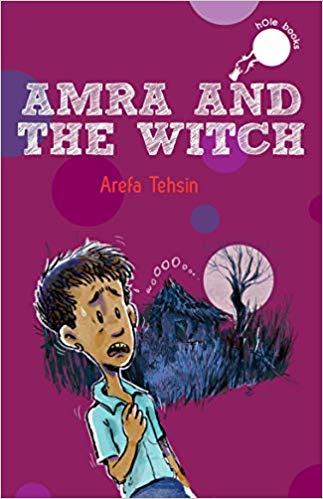Sajitha Nair
AMRA AND THE WITCH
By Arefa Tehsin. Illustrated by Chetan Sharma
Duckbill Books, 2018, pp. 65, R175.00
Inspired by a true-life encounter of Raza H Tehsin, this book is a fun read. The entire book is like a window through which you are watching one day from the lives of Amra and Veerma, two young boys, with their usual mischiefs, worries and innocence. The book doesn’t really give us much background about Amra and Veerma’s lives and families directly but it is the subtle mention of them and things surrounding them which gives away the background and helps us to imagine the characters. Illustrations are a big help for this. The emotions of the characters, their features, their personality, everything which is being spoken about or not in the story, is all there in the illustrations.
The fact that it is a true-life encounter can be felt in the way conversations takes place between these two friends. My favourite part of the conversation from this book is when Amra asks Veerma why he did not wait for his best friend before running to try and escape from Thakur, but he did not forget his tyre. To this Veerma replies, ‘Everyone has a best friend. How many kids have a tyre? And besides, you could run on your own from there. My tyre couldn’t.’ The reason this line of Veerma’s is my favourite is probably because I might have answered the same. It somehow makes Veerma’s character more human which is another interesting thing about the book. It is like one of those movies where the side character of the movie seems more interesting than the lead character. Though it might not be the intention of the author, still because of the title of the book, Amra automatically becomes the lead character.
Another unintentional glitch in the book is the frequent breaks in the story. For example, at the beginning itself, the story starts with the witch but suddenly it disappears from the third paragraph and re-appears only at the end of the first chapter. Now, this might have been interesting if there was some connecting thread between the first two paragraphs and the third paragraph. These sudden breaks occur in the story in quite a few places. It is as if the story has an unstable pulse: the lines going up and down and up. It may be good to keep the story unpredictable, but it is very disturbing for binge readers who as soon as they open a book, think of themselves getting into a boat ride flowing with the river of the story. So the unnecessary stops in between the start point and endpoint might not be so pleasant.


Wow, incredible blog layout! How long have you ever been running a blog for?
you made running a blog look easy. The whole look of your web site is fantastic, let alone
the content! You can see similar here ecommerce
Nice blog here! Additionally your website quite a bit up fast!
What host are you the usage of? Can I am getting your associate link for your host?
I wish my website loaded up as fast as yours lol I saw similar
here: Sklep online
Good day! Do you know if they make any plugins to help with Search Engine Optimization? I’m trying to get my blog
to rank for some targeted keywords but I’m not seeing very good results.
If you know of any please share. Appreciate it!
You can read similar article here: Dobry sklep
It’s very interesting! If you need help, look here: ARA Agency
Hey there! Do you know if they make any plugins to help with Search Engine
Optimization? I’m trying to get my site to rank for some targeted keywords but I’m not seeing very good success.
If you know of any please share. Appreciate it! You can read similar text here: Link Building
Hey there! Do you know if they make any plugins to assist with Search Engine Optimization? I’m trying to get my blog to rank for some
targeted keywords but I’m not seeing very good results.
If you know of any please share. Many thanks! I
saw similar article here: Hitman.agency